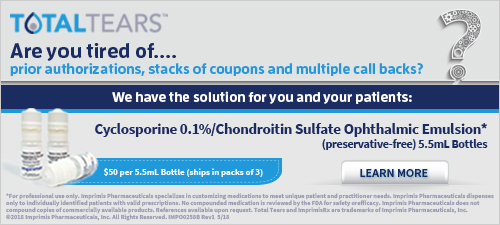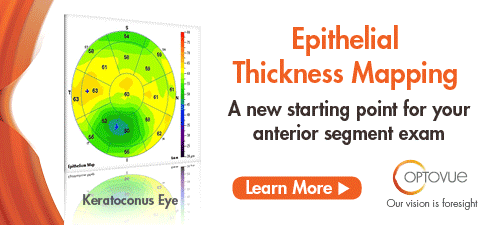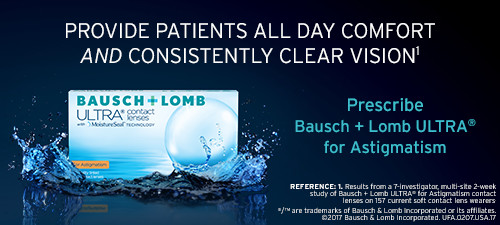
A
weekly e-journal by Art Epstein, OD, FAAO
Off the Cuff: On Improving Our Ability to Detect Glaucoma: Guest Author Don Hood
As regular readers know, we don’t often run guest editorials, but from time to time important topics arise that demand broad attention. Don Hood is the James F. Bender Professor of Psychology and Professor of Ophthalmic Science in Ophthalmology at Columbia University. He currently serves as Editor-in-Chief of Investigative Ophthalmology and Visual Science and on the Editorial Board of the Journal of Glaucoma. Don received the Research Excellence Award from the Optometric Glaucoma Society in 2014 and is among the world’s brightest minds in understanding visual system function and physiology. He has a special interest in glaucoma. What Don has to say is very important:
|
|||||
 |
||
| Macular Choroidal Thickness in Highly Myopic Women During Pregnancy and Postpartum: a Longitudinal Study | ||||
High myopia, a cause of serious visual impairment, is a significant global public health concern. Researchers investigated longitudinal changes in macular choroidal thickness (CT) during pregnancy and six-months postpartum in women with high myopia (HM). A prospective longitudinal study was conducted in highly myopic (HM) pregnant women during the course of pregnancy (n=42 eyes, 42 patients) and six months postpartum (n=40 eyes, 40 patients, two cases lost). Macular CT was measured via enhanced-depth imaging (EDI)-optical coherence tomography (OCT) (EDI-OCT). Intraocular pressure (IOP), axial length (AL), refractive error, mean arterial pressure (MAP), mean ocular perfusion pressure (MOPP) and body mass index (BMI) were also measured. Macular CTs of HM pregnant women (214.3μm ± 52.3μm) increased significantly during the third trimester of pregnancy compared with postpartum women (192.7μm ± 51.9μm). No significant differences in AL, refractive error or MAP were found between pregnant and postpartum groups. During pregnancy, macular CT was negatively correlated with AL and positively correlated with refractive error. No correlations between macular CT and age, IOP, MOPP, MAP or BMI were found. The study revealed the presence of a significantly thicker choroid during the third trimester of pregnancy compared with six-months postpartum in HM women. Macular CT positively correlated with refractive error and negatively correlated with AL during pregnancy, but did not correlate with gestational age, MOPP, IOP, MAP or BMI. |
||||
SOURCE: Chen W, Li L, Zhang H, et al. Macular choroidal thickness in highly myopic women during pregnancy and postpartum: a longitudinal study. BMC Pregnancy Childbirth. 2018;18(1):220. |
||||
 |
||
| Patient Characteristics and Outcomes of Retained Lens Fragments in the Anterior Chamber After Uneventful Phacoemulsification | ||||
Using Current Procedural Terminology codes 2006 to 2018, patients with a diagnosis of retained nuclear fragment in the anterior chamber after uncomplicated phacoemulsification cataract extraction were identified to determine patient characteristics and outcomes for developing retained nuclear fragments in the anterior chamber after phacoemulsification in at-risk populations. Patient demographics, ocular biometrics, treatments and clinical management were recorded. Main outcome measures were visual outcomes and visual acuity at regular follow-up appointments.
Nineteen patients (13 with myopia) were identified. Most patients (n=15) presented with corneal edema and anterior chamber inflammation, and the fragments were diagnosed on slit-lamp exams in most patients (n=18). Seventeen retained fragments were found in the inferior angle. The mean axial length, keratometry and anterior chamber depth (ACD) values were 23.58mm, 44.93D and 2.97mm, respectively. The mean time from cataract extraction to fragment removal was 34.7 days. The final corrected distance visual acuity ranged from 20/20 to 20/400. Three patients developed cystoid macular edema, and two patients had corneal complications after fragment removal. A comparison between the patients in this study and cited cases indicated that long eyes, steep corneas and a shallow ACD might be risk factors for retained nuclear fragments in patients having cataract extraction. Prompt identification and surgical removal provided the best visual outcomes because most cases proved refractory to steroid treatment. |
||||
SOURCE: Norton JC, Goyal S. Patient characteristics and outcomes of retained lens fragments in the anterior chamber after uneventful phacoemulsification. J Cataract Refract Surg. 2018; Jun 13. [Epub ahead of print]. |
||||
 |
||
| Efficacy of Toric Intraocular Lens Implantation in Eyes with High Myopia: a Prospective, Case-controlled Observational Study | ||||
This prospective, clinical observational study aimed to evaluate the efficacy of toric intraocular lenses (IOL) to achieve rotational stability and astigmatism correction in eyes with high myopia. A total of 27 consecutive cataract patients (39 eyes) with pre-existing corneal astigmatism (1.5D to 3.5D) were divided into two groups according to their refractive status: one group of 18 eyes with high myopia (-12.5D to 6.0D) and another group consisting of 21 eyes with emmetropia or low myopia (-3.0D to 0.0D). All eyes underwent cataract phacoemulsification surgeries by the same surgeon, with the implantation of an AcrySof Toric IOL at the pre-designed degree. Uncorrected visual acuity, best-corrected visual acuity and phoropter examination results were recorded at the 1st day, 1st week, 1st month and 3rd month after the surgery. By analyzing digital images from slit-lamp photography with a self-designed software, the rotational stability was observed. The contrast sensitivity was also measured.
No significant difference in the baseline and postoperative residual astigmatism was identified between the two groups. In addition, no significant difference in the degree of rotation was observed between the two groups. All patients had significantly improved visual quality after the surgery. Investigators observed an equal astigmatism-correction efficiency and rotational stability in the two groups. They concluded that a second auxiliary spot-penetrating incision, removal of visco-elastic substances and tight adherence of the IOL to the posterior capsular membrane were essential for a successful surgery. |
||||
SOURCE: Guo T, Gao P, Fang L, et al. Efficacy of toric intraocular lens implantation in eyes with high myopia: a prospective, case-controlled observational study. Exp Ther Med. 2018;15(6):5288-94. |
||||
 |
||
| News & Notes | ||||||||||
FDA Approves iDESIGN Refractive Studio
|
||||||||||
B+L Ultra For Astigmatism Contact Lenses Offer -2.75D Cylinder Power, Company Receives Pre-Market Approval for Envista Toric MX60T IOL
|
||||||||||
| Avedro Enrolls First Patient in Phase III Epi-on Corneal Cross-Linking Trial for Progressive Keratoconus Avedro began enrolling patients in a Phase III clinical trial to evaluate the safety and efficacy of an epithelium-on corneal collagen cross-linking procedure to treat patients with progressive keratoconus. The multicenter, randomized, controlled trial of a novel corneal cross-linking procedure involves 275 patients with progressive keratoconus across approximately 20 sites in the United States. Read more. |
||||||||||
| EyePromise Hires New President & CFO EyePromise announced the appointments of Andreas Wolf as president and Peggy Stohr as chief financial officer. Wolf previously served as vice president and general manager of Young Dental, and before that, in various roles at Novus International. At EyePromise, Wolf takes responsibility for all of the company’s business activities and growth strategies. Stohr comes with a strong strategic financial and administrative background, having served at public and private medical device organizations. |
||||||||||
| RightEye Unveils Computer-based Vision Training for Visual Dysfunction RightEye unveiled its new EyeQ Trainer computer-based vision rehabilitation program at Optometry's Meeting 2018, which takes place June 20 to 24 in Denver, (booth #611). EyeQ Trainer gives optometrists a tool their patients can use at home to rehabilitate eye-movement issues. Through a series of simple exercises conducted on a personal computer or tablet with an internet connection during which patients engage in specific eye movements, RightEye EyeQ Trainer activates the eyes' muscles, as well as key elements of brain circuitry. The circuitry activation is intended to yield better functional vision, and smoother and more accurate eye movements that directly impact quality of life. Read more. |
||||||||||
| Orasis Closes $13 Million Series B Financing Orasis Pharmaceuticals closed a $13 million Series B financing, led by Visionary Ventures, with participation from Sequoia Capital, SBI (Japan) Innovation Ventures, LifeSci Venture Partners and other private investors. Proceeds will advance the company’s lead product candidate, CSF-1, an eye drop in development for the treatment of presbyopia symptoms, through completion of its Phase IIb clinical trial. Read more. |
||||||||||
|
||||||||||
|
Optometric Physician™ (OP) newsletter is owned and published by Dr. Arthur Epstein. It is distributed by the Review Group, a Division of Jobson Medical Information LLC (JMI), 11 Campus Boulevard, Newtown Square, PA 19073. HOW TO ADVERTISE |



